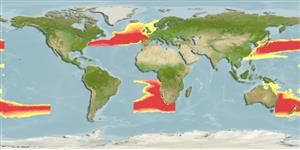>
Ophidiiformes (Cusk eels) >
Bythitidae (Livebearing brotulas)
Etymology: Parabrotula: Greek, para = the side of + Latin, brotula, -ae = little, bud, shoot (Ref. 45335).
Environment: milieu / climate zone / depth range / distribution range
Écologie
marin bathypélagique; profondeur 0 - 3000 m (Ref. 35509). Deep-water
Northeast Atlantic: most of the known specimens from the area (Ref. 36126). Eastern Atlantic: Gulf of Guinea, one specimen 0°42'S, 7°E (Ref. 10800). Southeast Atlantic: off East London, South Africa. Western Pacific: Japan and Australia (Ref. 11228).
Taille / Poids / Âge
Maturity: Lm ? range ? - ? cm
Max length : 5.4 cm SL mâle / non sexé; (Ref. 35509)
Description synthétique
Clés d'identification | Morphologie | Morphométrie
Épines dorsales (Total) : 0; Rayons mous dorsaux (Total) : 37 - 41; Épines anales: 0; Rayons mous anaux: 34 - 38. Body long, naked and compressed. Skin loose, thin but not gelatinous. Snout pointed. Gill opening large. Head and body uniformly dark brown in alcohol (Ref. 35852).
Found on the continental slope (Ref. 75154). Viviparous (Ref. 10800). Minimum depth from Ref. 58018.
Life cycle and mating behavior
Maturité | Reproduction | Frai | Œufs | Fécondité | Larves
Anderson, M.E., 1986. Parabrotulidae. p. 343. In M.M. Smith and P.C. Heemstra (eds.) Smiths' sea fishes. Springer-Verlag, Berlin. (Ref. 6608)
Statut dans la liste rouge de l'IUCN (Ref. 130435: Version 2024-2)
Menace pour l'homme
Harmless
Utilisations par l'homme
Pêcheries:
Outils
Articles particuliers
Télécharger en XML
Sources Internet
Estimates based on models
Preferred temperature (Ref.
123201): 3.7 - 10.6, mean 6 °C (based on 497 cells).
Phylogenetic diversity index (Ref.
82804): PD
50 = 0.8750 [Uniqueness, from 0.5 = low to 2.0 = high].
Bayesian length-weight: a=0.00102 (0.00046 - 0.00225), b=3.06 (2.88 - 3.24), in cm total length, based on all LWR estimates for this body shape (Ref.
93245).
Niveau trophique (Ref.
69278): 3.2 ±0.5 se; based on size and trophs of closest relatives
Résilience (Ref.
120179): Faible, temps minimum de doublement de population : 4,5 à 14 années (Assuming Fec<100).
Fishing Vulnerability (Ref.
59153): Low vulnerability (10 of 100).
